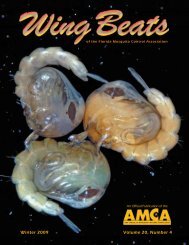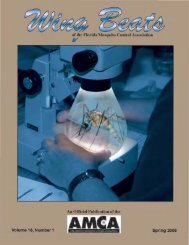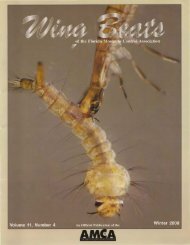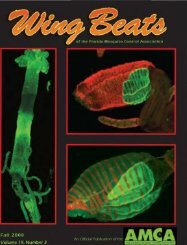Volume 23 Number 1 - Wing Beats - Wing Beats - Florida Mosquito ...
Volume 23 Number 1 - Wing Beats - Wing Beats - Florida Mosquito ...
Volume 23 Number 1 - Wing Beats - Wing Beats - Florida Mosquito ...
You also want an ePaper? Increase the reach of your titles
YUMPU automatically turns print PDFs into web optimized ePapers that Google loves.
30<br />
Figure 2: Seasonal frequency graph, showing the relative number of unmaintained swimming pools (without fish)<br />
in which various species of mosquito larvae were found each month, 2006 through 2008.<br />
the year in pools without fish.<br />
They were sometimes very numerous,<br />
though less common<br />
during the summer; see Figure<br />
2. Anopheles larvae were also<br />
observed throughout the year,<br />
but their numbers were seldom<br />
large. Culiseta inornata could be<br />
very numerous during November<br />
to March, Cx salinarius during<br />
November to May, and Cx coronator<br />
during July to November.<br />
Most larvae in pools with fish<br />
were Anopheles, sometimes<br />
present even when fish were<br />
abundant. Cx quinquefasciatus<br />
were observed only where fish<br />
numbers were low. Other mosquito<br />
species were almost never<br />
seen in pools with fish.<br />
In 2007, we initiated a research<br />
program to help guide the<br />
operational program. It was encouraging<br />
that so many pools had<br />
fish after the introductions in 2006,<br />
but we needed to understand<br />
why fish were missing from 14% of<br />
those pools. We wanted to know:<br />
• Did the fish fail to take hold<br />
in some of the pools to which<br />
they were introduced? Was this<br />
still a problem for introductions<br />
underway?<br />
• Did fish take hold after introduction,<br />
but drop out of the<br />
pools later? Were they continuing<br />
to disappear from pools in which<br />
they were established?<br />
• Was there still a fish survival<br />
problem in the pools?<br />
• How were ecological conditions<br />
in the pools affecting larval<br />
abundance, fish abundance,<br />
and the effectiveness of fish for<br />
larval control?<br />
Spring 2012 <strong>Wing</strong> <strong>Beats</strong><br />
We monitored a selection of pools<br />
for an extended period after introducing<br />
fish. We also conducted<br />
experiments to address specific<br />
concerns. For example, it was<br />
not unusual to see empty bleach<br />
bottles because people had<br />
dumped bleach in a dirty pool<br />
to “clean it up.” However, bleach<br />
could wipe out the fish and other<br />
aquatic predators, converting a<br />
pool into prime mosquito habitat<br />
if left unmaintained. To gain<br />
perspective, we poured four<br />
Figure 3: A pool treated experimentally with bleach to see its impact<br />
on the fish population. Fish normally thrived in this pool. Dumping<br />
four gallons of bleach led to high fish mortality, but the fish population<br />
recovered within a month.
















